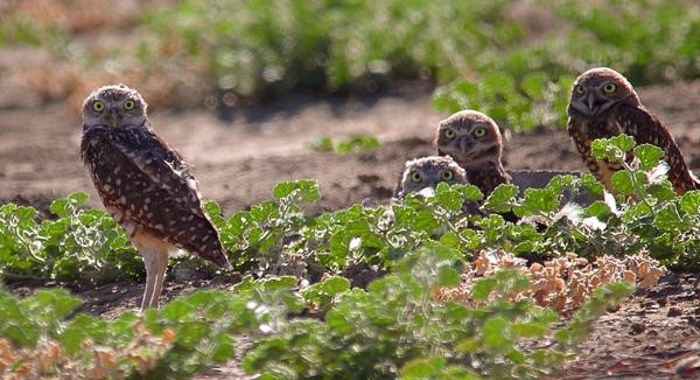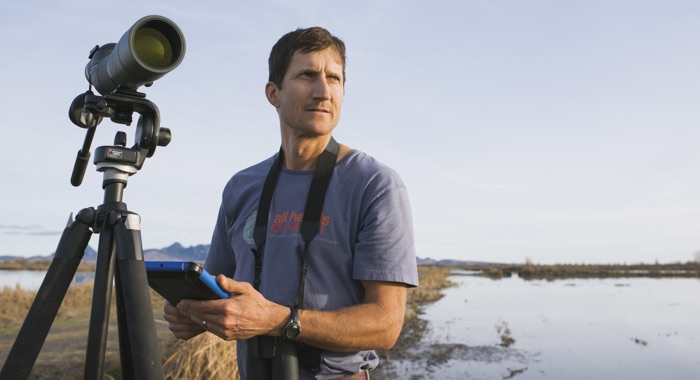California is the leading agricultural state in the country and it’s agriculture generates more than $45 billion annually. About 10 million acres of the state is intensively cultivated land, using roughly 80 percent of the developed water supply. Only a small fraction of these lands are managed deliberately in ways that minimize impacts to nature and maximize the services that nature can provide back to the farm. This has come at a substantial price to nature and the future resilience of agriculture.
Maintaining a mix of natural areas along farm fields and along waterways can provide vital habitat and movement corridors for wildlife, as well as important services like pollination and pest control from native insects, erosion control, and improved water quality. Sustainable management of soils and crops themselves can further reduce the ecological footprint of the land use, and indeed provide habitat for some native species.
Conservancy scientists are investigating these co-benefits, to inform how policy and market incentives could promote food production practices that sustain nature as well as people.


Tamara S Wilson, Benjamin M Sleeter, D Richard Cameron
This publication discusses how land use changes in Mediterranean California will drive changes in water use between urban uses and annual vs. perennial crops. The authors used a state-and-transition…Gary L. Ivey, Caroline P. Herziger, David A. Hardt, Gregory H. Golet
Understanding the geographic distribution and long-term dynamics of Sandhill Crane (Grus canadensis) foraging areas and night roost sites is fundamental to their conservation and management. The…Daniel S. Karp, Patrick Baur, Edward R. Atwill, Kathryn De Master, Sasha Gennet, Alastair Iles, Joanna L. Nelson, Amber R. Sciligo, Claire Kremen
In 2006, an E. coli outbreak linked to spinach grown in California’s Central Coast region catalyzed reforms in vegetable production. Without evidence, wildlife was targeted as a disease vector…W. David Shuford , Matthew E. Reiter, Khara M. Strum, Michelle M. Gilbert , Catherine M. Hickey, Greg Golet
Although agricultural intensification is one of the largest contributors to the loss of global biodiversity, agricultural landscapes can provide valuable habitat for birds. Recognizing this, wildlife…Johnston, A., D. Fink, M. D. Reynolds, W. M. Hochachka, B. L. Sullivan, N. E. Bruns, E. Hallstein, M. S. Merrifield, S. Matsumoto, S. Kelling
Global declines in migratory species in response to accelerating habitat destruction and climate change challenge the scope and scale of conservation efforts. The ability to pinpoint where and when…Daniel S. Karp, Sasha Gennet , Christopher Kilonzo, Melissa Partyka, Nicolas Chaumont, Edward R. Atwill, Claire Kremen
In 2006, a high profile outbreak of E. coli in spinach was traced to California’s Central Coast. After that outbreak, produce growers were pressured to minimize potential presence of wild…Jennifer K. Carah, Jeanette K. Howard, Sally E. Thompson, Anne G. Short Gianotti, Scott D. Bauer, Stephanie M. Carlson, David N. Dralle, Mourad W. Gabriel, Lisa L. Hulette, Brian J. Johnson, Curtis A. Knight, Sarah J. Kupferberg, Stefanie L. Martin, Rosamond L. Naylor, Mary E. Power
Marijuana cultivation can have significant negative collateral effects on the environment that are often unknown or overlooked. This study focuses on California, where by some estimates, 60–70%…Daniel Karp, Sasha Gennet, Rodd Kelsey
Eric Hallstein, Matt Miller
Golet G.H., D.L. Brown, M. Carlson, T. Gardali, A. Henderson, K.D. Holl, C.A. Howell, M. Holyoak, J. Hunt, G.M. Kondolf, E.W. Larsen, R.A. Luster, C. McClain, C. Nelson, S. Paine, W. Rainey, Z. Rubin, F. Shilling, J.G. Silveira, H. Swagerty, N.M. Williams, D.M. Wood
Large-scale ecosystem restoration projects seldom undergo comprehensive evaluation to determine project effectiveness. Consequently, there are missed opportunities for learning and strategy…Joshua H. Viers, John N. Williams, Kimberly A. Nicholas, Olga Barbosa, Inge Kotzé, Liz Spence, Leanne B. Webb, Adina Merenlender, Mark Reynolds
As an essential component of food security, agricultural landscapes must play a role in conservation efforts because they occupy large areas of land, are adjacent to critical habitat, and both depend…Gennet, S., J. Howard, J. Langholz, K. Andrews, M.D. Reynolds, S.A. Morrison
This paper discusses the 2006 outbreak of toxic foodborne E. coli and its impact on wildlife. The authors explain how farming practices for food safety that target wildlife can damage ecosystems but…Golet G.H., J. Hunt, D. Koenig
Floodplains often are managed both for agriculture and as habitat for native species. On the Sacramento River, farmers have expressed concern that natural areas may be sources of pests to adjoining…Golet G.H., T. Gardali, C. Howell, J. Hunt, R. Luster, B. Rainey, M. Roberts, H. Swagerty, N. Williams
Studies that assess the success of riparian restoration projects seldom focus on wildlife. More often, vegetation is studied, with the assumption that animal populations will recover once adequate…Golet G.H., M.D. Roberts , E.W. Larsen, R.A. Luster, R. Unger, G. Werner, G.G. White.
River restoration projects have the potential to influence many of the services that rivers provide to people, yet rarely is this studied in a comprehensive manner. This paper reports on a set of…